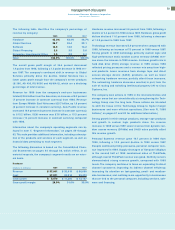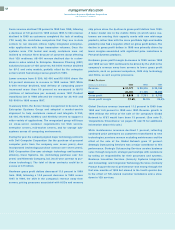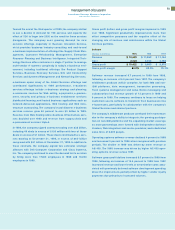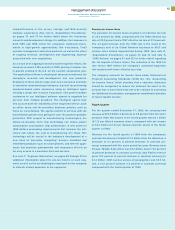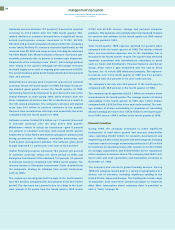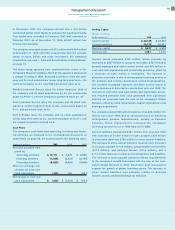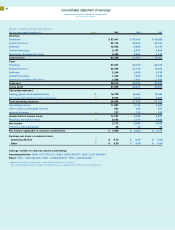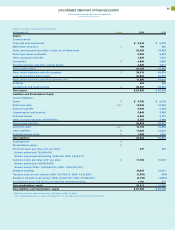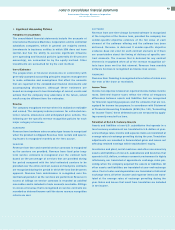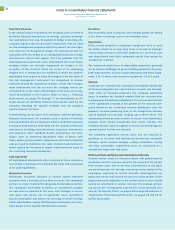IBM 1999 Annual Report Download - page 65
Download and view the complete annual report
Please find page 65 of the 1999 IBM annual report below. You can navigate through the pages in the report by either clicking on the pages listed below, or by using the keyword search tool below to find specific information within the annual report.
management discussion
International Business Machines Corporation
and Subsidiary Companies
Employees and Related Workforce Percentage
Changes
1999 1998 1997 1999-98 1998-97
IBM/ wholly
owned
subsidiaries 307,401 291,067 269,465 5.6 8.0
Less than
wholly owned
subsidiaries 17,176 21,704 20,751 (20.9) 4.6
Complementary 29,800 36,900 43,000 (19.2) (14.2)
IBM employees, including wholly owned subsidiaries, increased
by more than 16,000 in 1999. The growth areas of the company,
Global Services and the Software Group, continue to drive the
increase; Global Services hired approximately 17,000 in 1999.
Acquisitions also contributed to the increase. The company also
continues to reduce its infrastructure and to withdraw from
certain businesses, thereby offsetting some of the growth. For
example, during 1999, IBM sold its Global Network to AT&T,
resulting in the loss of about 5,300 employees.
The decrease in employees in the less than wholly owned
subsidiaries over the last year reflects a number of entities that
were converted to a wholly owned status, such as Global
Services in India and MiCRUS in the U.S., or divested during the
year. Partially offsetting the decrease was continued growth
in Global Services, notably in Australia, and in a number of
subsidiaries in China.
The company’s complementary workforce is an approximation
of equivalent full-time employees hired under temporary, part-
time and limited-term employment arrangements to meet
specific business needs in a flexible and cost-effective manner.
Year 2000
The issues raised by the transition to the Year 2000 presented
a pervasive and unprecedented global challenge to IBM, its
customers, partners, suppliers and employees, as well as to gov-
ernments, communities and individuals. The company believes
that the overall uneventful arrival of the Year 2000 is testimony
to the hard work and investment of organizations and individu-
als around the world.
With respect to the company’s own operations, it prepared more
than one million critical items for the transition, including PCs and
servers, application software, and manufacturing tools and
instruments. In addition, 2,500 suppliers, 750 business partners
and 200 subsidiaries were assessed for risk mitigation planning
purposes. The company estimates that it will have spent approx-
imately $500 million over a multi-year period in these efforts,
including conversion, testing and contingency planning.
Over the past five years, the company undertook numerous
initiatives to help customers prepare for the Year 2000 includ-
ing contacting customers around the world to help promote
awareness of Year 2000 issues; developing a range of service
offerings and tools to help customers assess, develop and
execute plans to make their systems Year 2000 ready; and mak-
ing the company’s own current hardware and software offerings
Year 2000 ready. To illustrate the extent of the company’s efforts,
more than one million customers used the company’s technical
support Year 2000 Web site; and the company’s Global Services
organization processed more than one billion lines of customer
code. Further, the company found that a large number of its
enterprise customers locked down their information technology
systems and postponed technology purchases heading into the
Year 2000 transition, which adversely affected the company’s
business performance during the second half of 1999. See the
Results of Operations and Financial Condition sections within
the Management Discussion for further information.
In the near term, the company recognizes the need to maintain
its vigilance in the event Y2K issues do arise. Further, some
commentators believe that a significant amount of litigation will
arise from Year 2000 issues. The company continues to believe
that it has good defenses to any such potential claims brought
against it.
The Year 2000 statements set forth above are designated as
“Year 2000 Readiness Disclosures” pursuant to the Year 2000
Information and Readiness Disclosure Act (P.L. 105-271).
63


